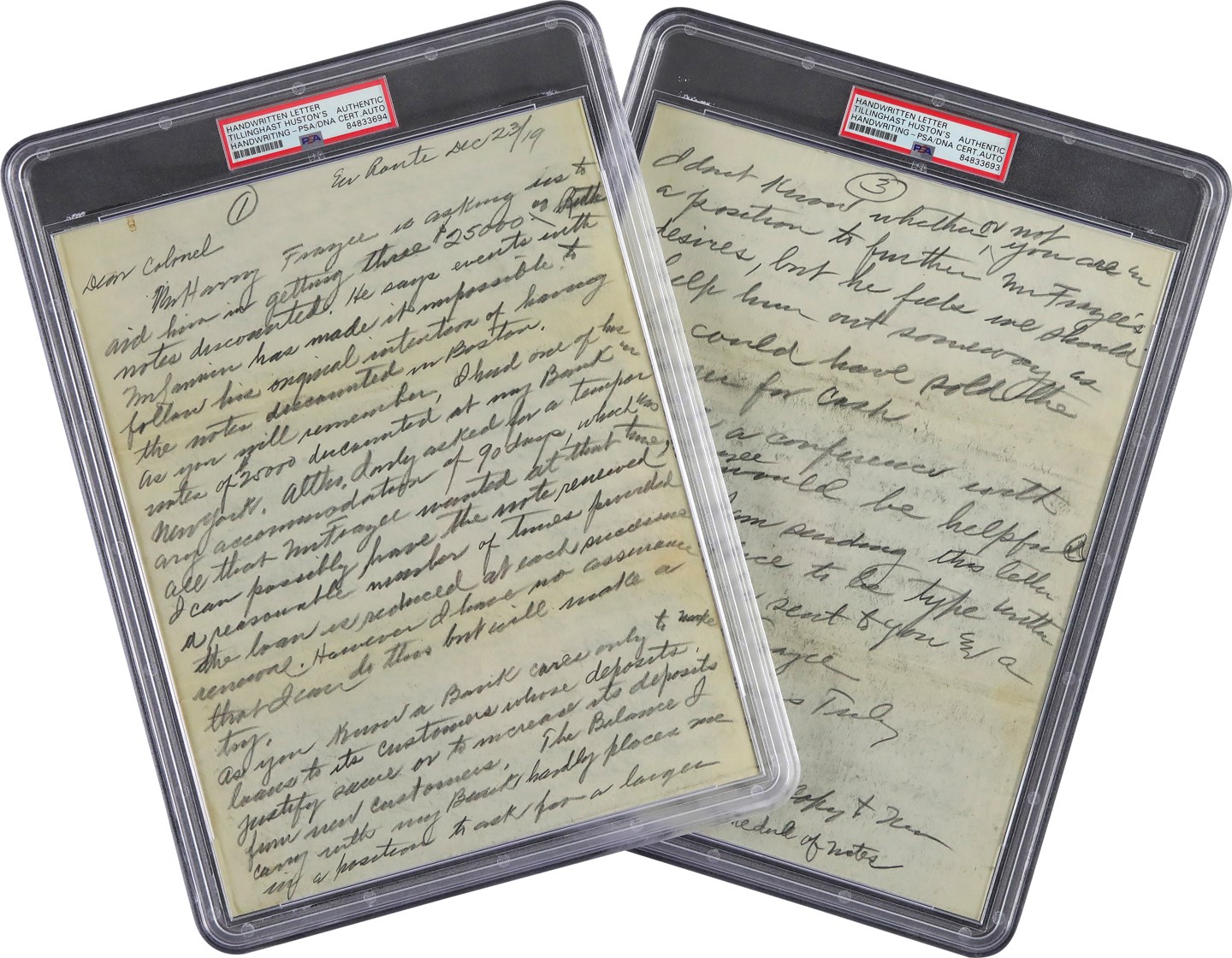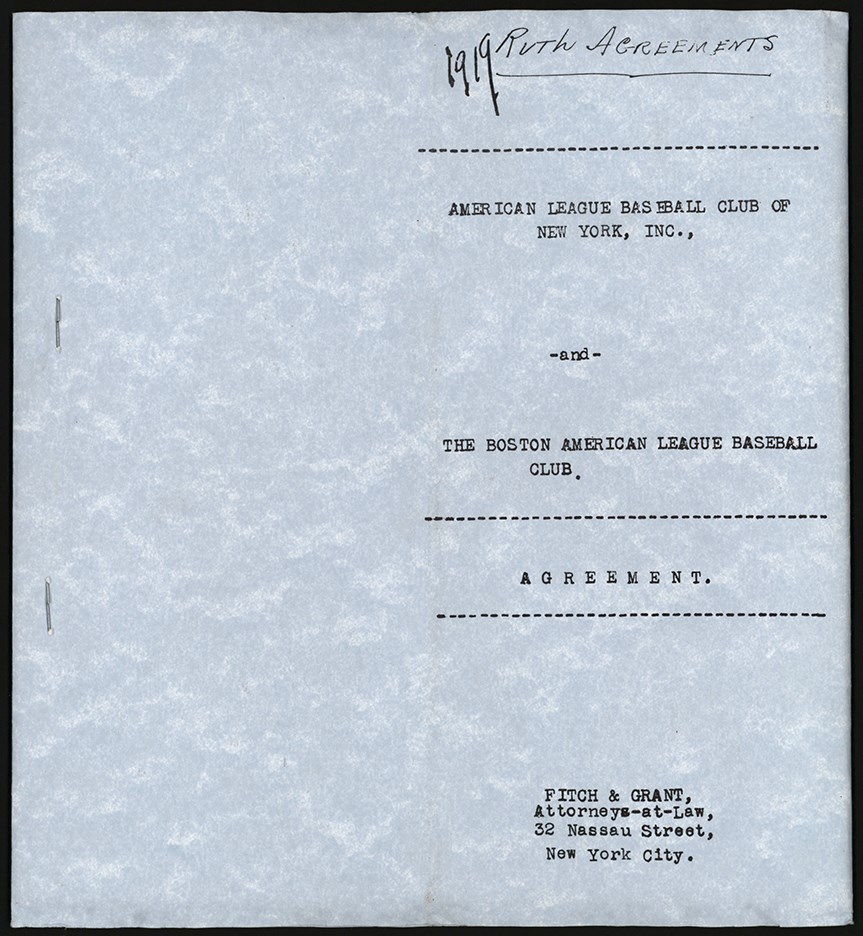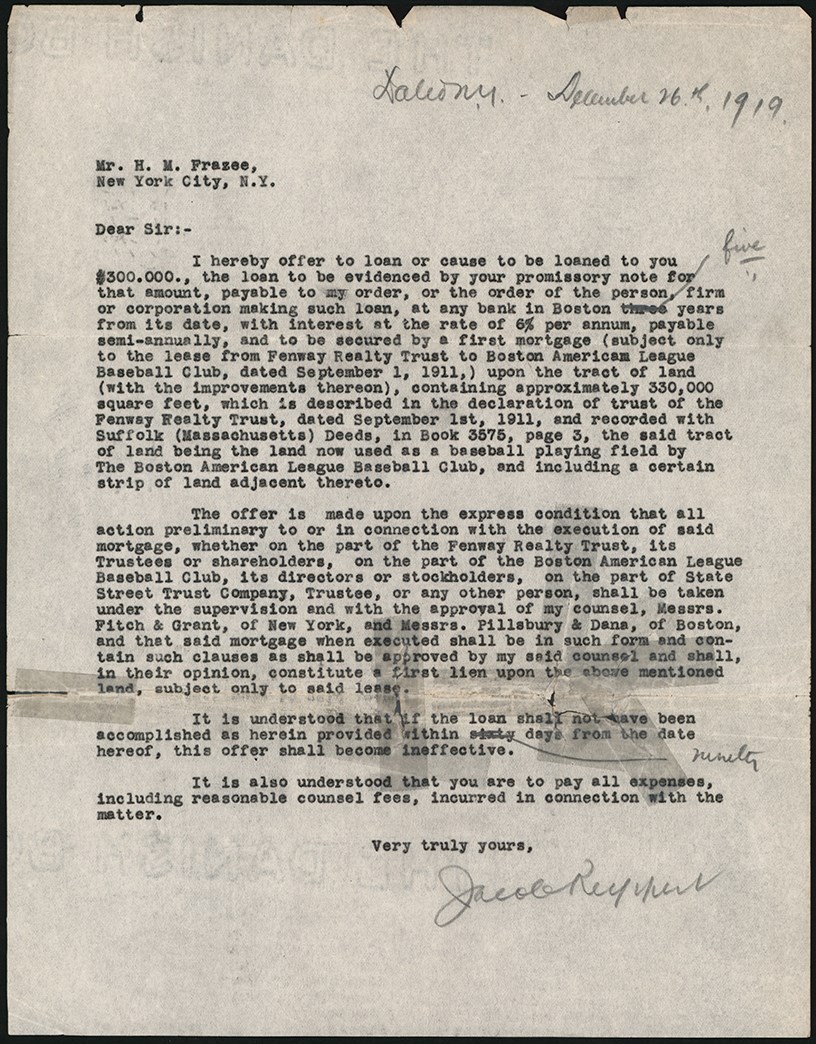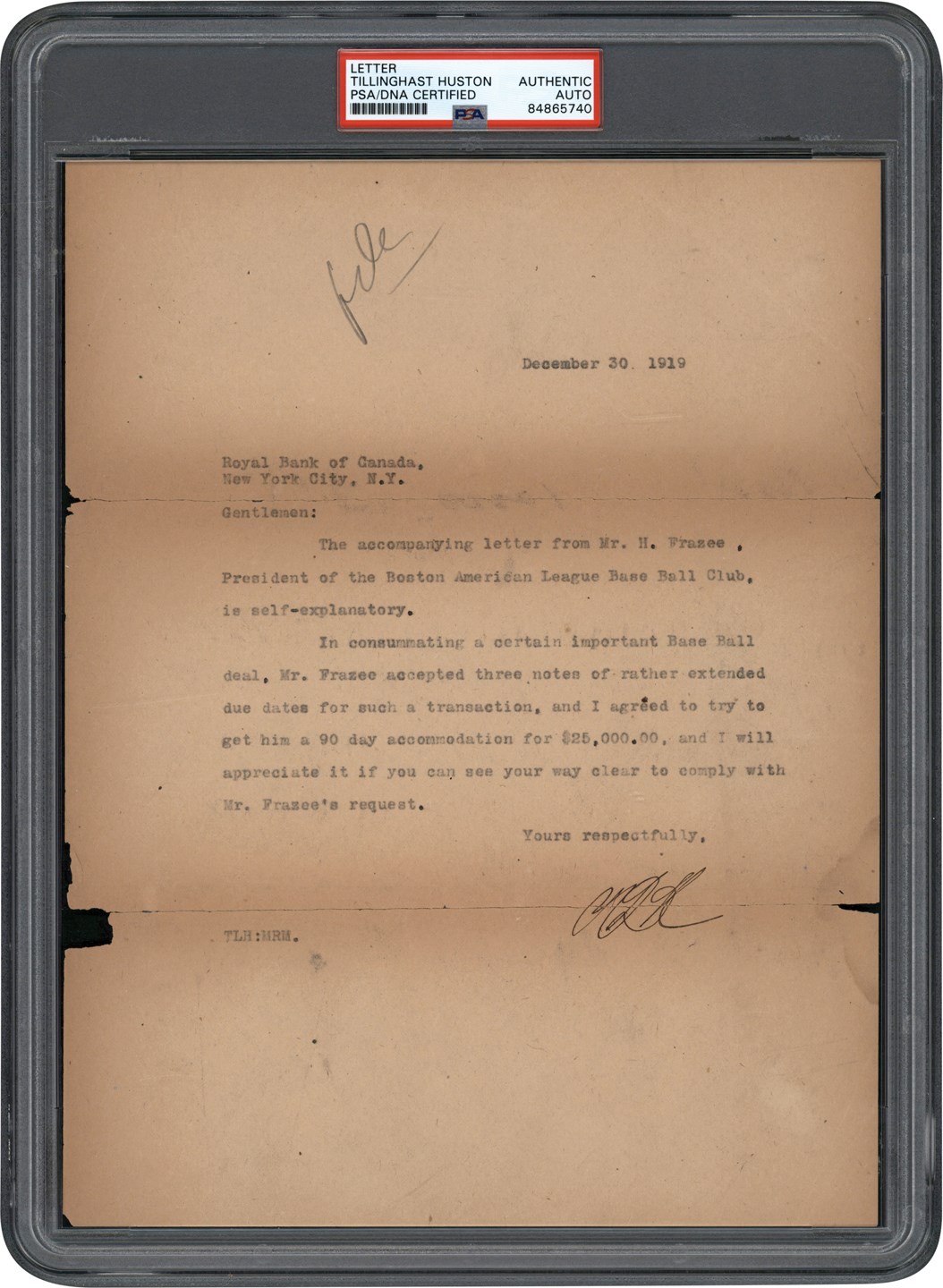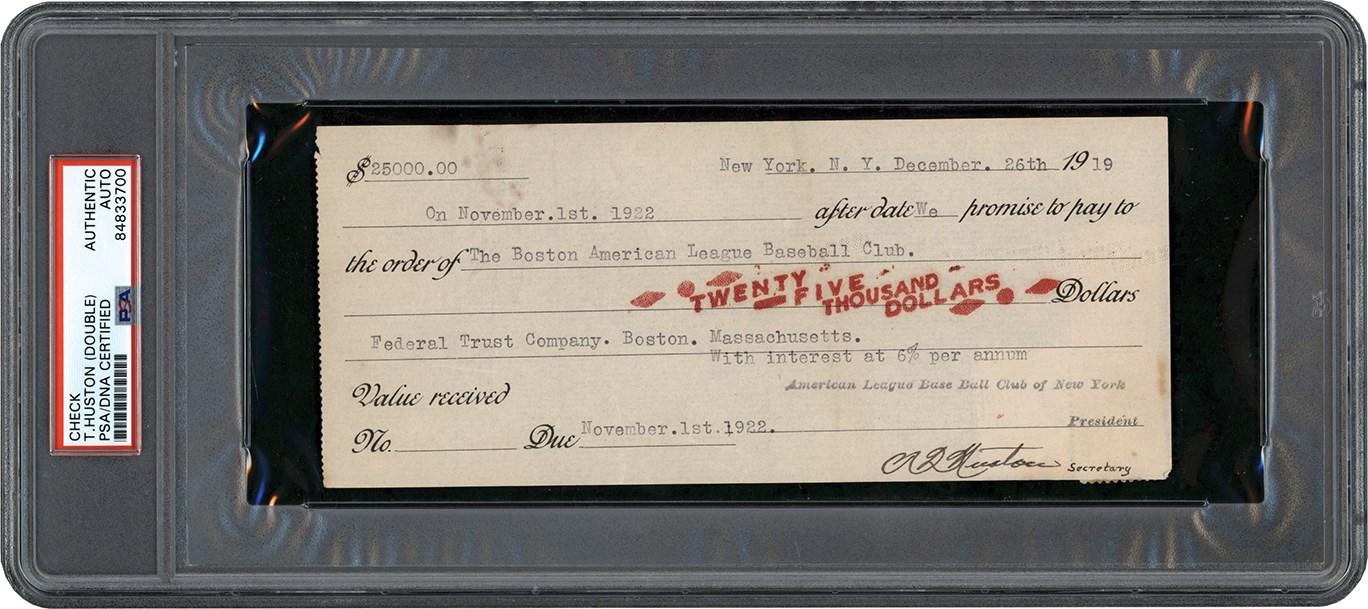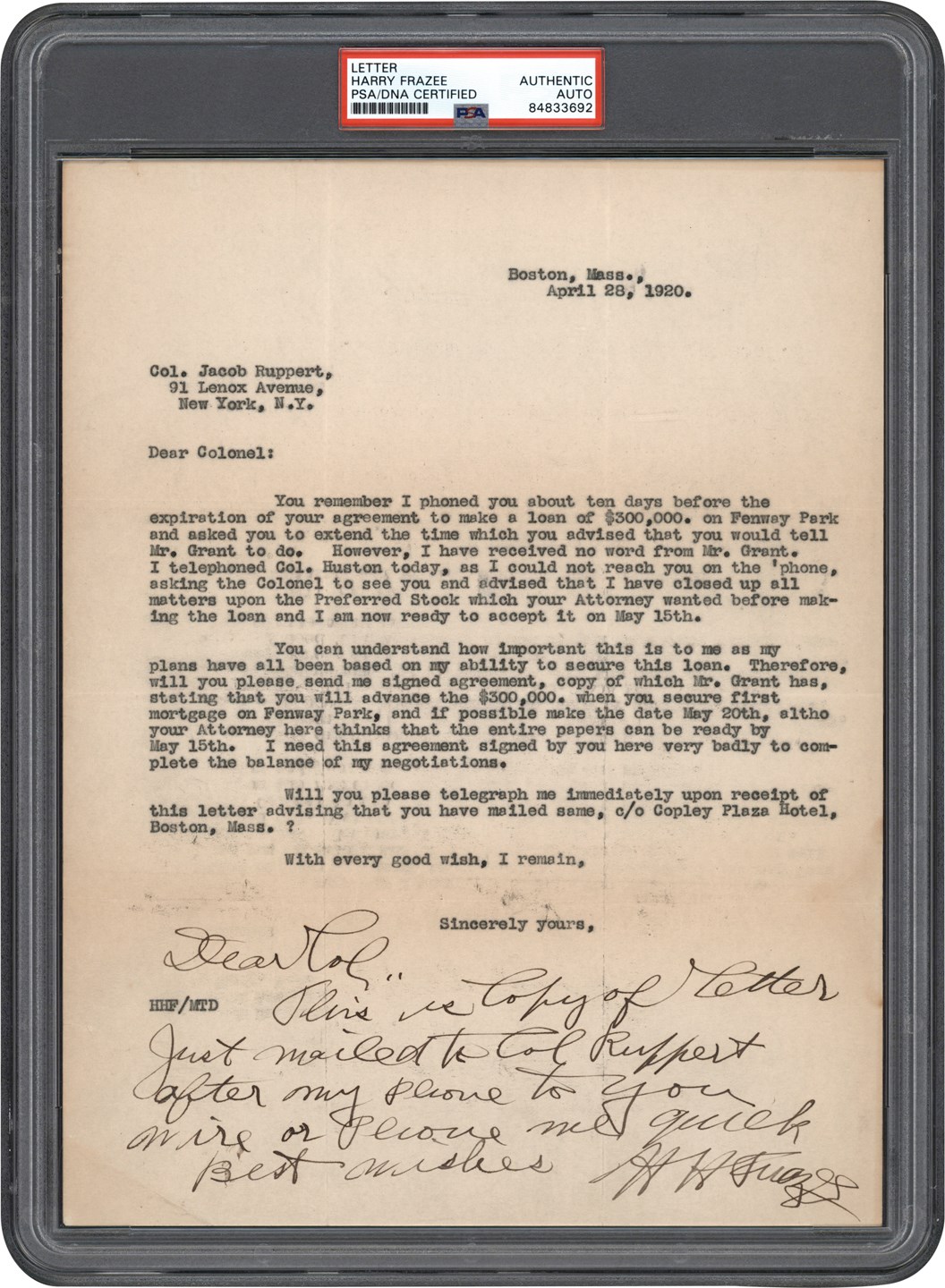Consign Your Best Items with Lelands. We Also Pay Cash on the Spot! Learn More Here.
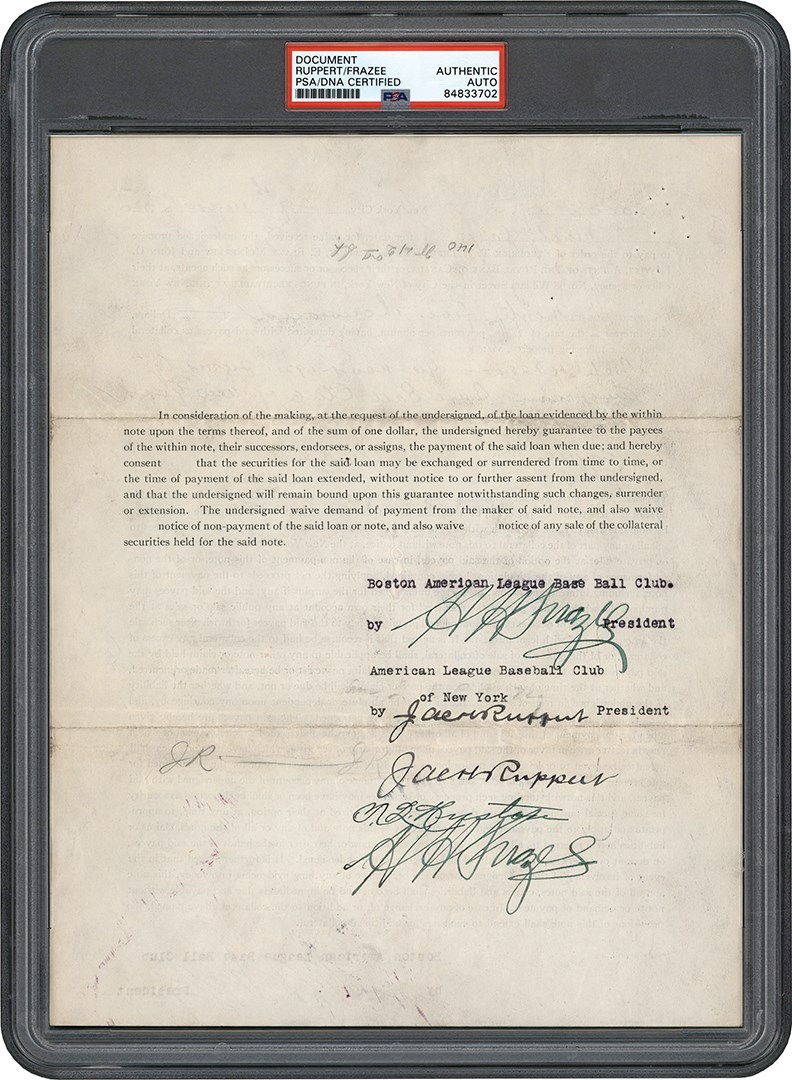
1920 Harry Frazee Promissory Note Directly Relating to the Sale of Babe Ruth (ex-Barry Halper Collection)
<p class="MsoNoSpacing"><span style="font-size: 10pt; font-family: Verdana, sans-serif;">Promissorynote in the amount $25,000, issued by Boston Red Sox owner Harry Frazee to TheRoyal Bank of Canada on March 29, 1920, signed three times by Frazee, twice byNew York Yankees owner Jacob Ruppert, and once by New York Yankees coowner T.L. Huston. Encapsulated by PSA, with each of the signatures certified as“Authentic.” According to the terms of the note, Frazee is to repay the Bank ofCanada $25,000, plus six percent interest per annum, in ninety days. </span></p><p class="MsoNoSpacing"><span style="font-size: 10pt; font-family: Verdana, sans-serif;"> </span><span style="font-size: 10pt; font-family: Verdana, sans-serif;">Thisnote has great historical significance because as collateral for the loan,Frazee puts up one of the $25,000 promissory notes he received from the NewYork Yankees as part of the purchase price for Babe Ruth’s contract threemonths prior. Frazee has signed the one-page document three times in greenfountain pen; Once on the front in acceptance of the main terms of the loan,and twice on the reverse, in acceptance of additional terms. The note has alsobeen signed on the reverse twice in black fountain pen by Yankees owner JacobRuppert and once in green fountain pen by Yankees co-owner T. L. Huston. (Thesignatures average 9/10.) The note (8.5x11”) displays two horizontal folds,staple holes in the upper left corner, and light creases. In Very Goodcondition overall.</span></p><p><span style="font-size: 10pt; font-family: Verdana, sans-serif; color: black;">Thereason Harry Frazee sold Babe Ruth's contract to the Yankees on December 26,1920, was because he was in desperate need of cash. He owed $262,000 on anoutstanding note to former Boston Red Sox owner Joseph Lanin, from whom hepurchased the club, he needed to contribute $100,000 in cash equity for atheater he was purchasing, and his most recent theatrical productions were inthe red. Even after the sale of Ruth's contract to the Yankees for $100,000 anda $300,000 loan on December 26, 1919, Frazee was still strapped for cash.</span></p><p style="font-variant-ligatures: normal;font-variant-caps: normal;orphans: 2;widows: 2;-webkit-text-stroke-width: 0px;text-decoration-thickness: initial;text-decoration-style: initial;text-decoration-color: initial;word-spacing:0px;"><span style="font-size: 10pt; font-family: Verdana, sans-serif; color: black;">Oneof Frazee's problems centered around still unsettled issues with his originalFenway Park mortgage. Until that matter was settled he could not avail himselfof the Yankees $300,000 loan (Fenway Park was listed as collateral for theloan). Also, the $100,000 that Frazee received from the Yankees was not inone lump sum. Frazee agreed to take $25,000 in cash, with the remainder to bepaid in three notes of $25,000, each coming due, respectively, on November 1stover the next three years. The initial $25,000 that he received in cash, wasnot nearly sufficient to cover his debts. Faced with this mounting financialpressure, Frazee immediately began borrowing money, using the three Yankeesnotes as collateral for his loans.</span></p><p class="MsoNoSpacing"><span style="font-size: 10pt; font-family: Verdana, sans-serif;">TheNew York Yankees owners Jacob Ruppert and T. L. Huston, as issuers of theoriginal note, were instrumental in helping him secure his loan from the RoyalBank of Canada, as is evidenced by the additional four documents that accompanyit. One is a New York Yankees one-page typed file-copy letter, dated March 27,1920, sent to the Royal Bank of Canada. As noted in the letter, the Frazeepromissory note offered here was the second loan issued by the Royal Bank ofCanada using the Yankees November 1, 1921, note as collateral. The first wasissued on December 29, 1919, and this agreement was in essence, a renewal ofthat agreement. As such, the Yankees included a check in the amount of $375 tocover the interest due on the original loan, which is noted by a handwrittenaddendum at the base of the page. The three additional accompanying documentsare as follows: 1) Telegram sent by Huston to the Yankees front office on March28, 1920, instructing the club to mail the offered promissory note to the Bankof Canada by Monday morning (8x6.5”; FR-GD, with tape repairs); 2) Telegramsent by the Yankees to Huston on March 29, 1920, informing him that the notehas been sent to the Royal Bank of Canada, as instructed (8x7”; FR-GD, withtape repairs); and 3) Postal “Return Receipt” card, dated March 29, 1920,confirming delivery to the Royal Bank of Canada (5x3”; VG; attached to thesecond telegram dated March 29th).</span></p>These documents, along with nearly every other surviving document relating to the sale of Babe Ruth to the New York Yankees, originates from the estate of Ed Barrow, who was manager of the Boston Red Sox at the time of the transaction, and soon after became the longtime business manager/general manager of the New York Yankees. Many years after Barrow's death, legendary collector Barry Halper purchased his entire business archive from the Barrow family, which included dozens of documents relating to Boston's historic sale of Ruth. (Barry Halper's collection is considered by many to have been the finest private baseball-memorabilia collection ever assembled.) In 1999, Halper sold nearly his entire collection at auction through Sotheby's in New York (the collection was so vast that it took over a week of twice-daily live auctions and three months of weekly internet sales to liquidate it). Lot 560 in the live-auction portion of the sale featured a large collection of documents relating to the sale of Ruth, from which these documents, as well as every other "sale of Ruth" document featured in this auction, originates. The entire content of Lot 560 in the 1999 Sotheby's Halper Collection auction has been consigned to this auction by the original purchaser, making this just the third time since 1919 that these historically significant documents will have traded hands.
Past Sports Card, Memorabilia, Non-Sports Card and Collecitble Auction Items
Other past auction items that may be of interest to you.

